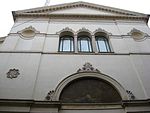Piazza delle Erbe, Padua
Commons category link is locally definedPiazzas in PaduaUse mdy dates from July 2021

Piazza delle Erbe is one of the many squares in the historic center of Padua. For centuries, with Piazza della Frutta, it was the commercial center of the city. In the two squares is one of the largest markets in Italy. Unlike Piazza dei Signori, the civic theater of celebrations, Piazza delle Erbe was the site of the folk festivities. The square is dominated by the imposing Palazzo della Ragione.
Excerpt from the Wikipedia article Piazza delle Erbe, Padua (License: CC BY-SA 3.0, Authors, Images).Piazza delle Erbe, Padua
Piazza delle Erbe, Padua San Giuseppe
Geographical coordinates (GPS) Address Nearby Places Show on map
Geographical coordinates (GPS)
| Latitude | Longitude |
|---|---|
| N 45.406944444444 ° | E 11.875 ° |
Address
Piazza delle Erbe
Piazza delle Erbe
35149 Padua, San Giuseppe
Veneto, Italy
Open on Google Maps










